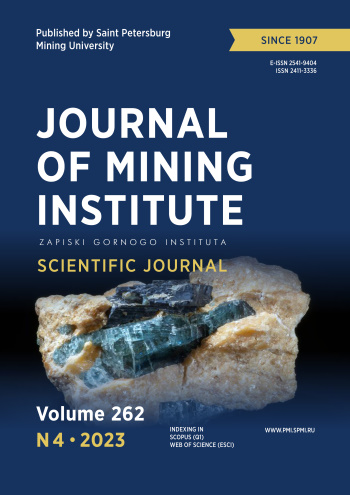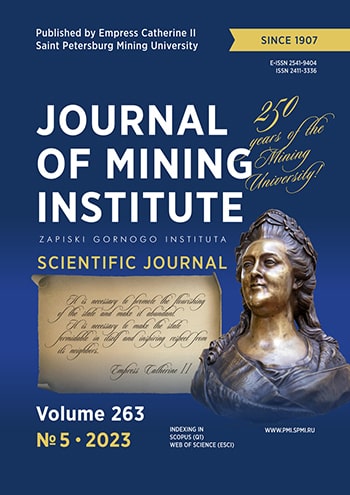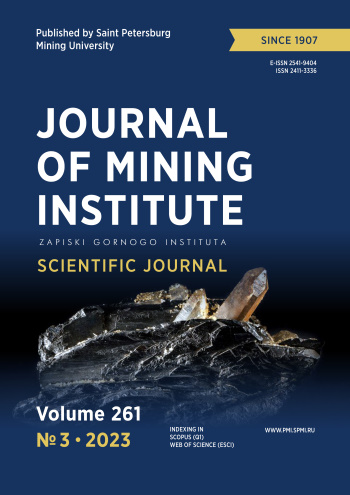-
Date submitted2021-12-15
-
Date accepted2022-09-12
-
Online publication date2023-03-16
-
Date published2023-08-28
Substantiation and selection of the design parameters of the hydroficated equipment complex for obtaining backfill mixtures from current enrichment tailings
The issue of the influence of the concentration of the solid phase on the reduction of energy costs and specific energy consumption during pulp transportation is considered. The procedure for preparing slurry from the current enrichment tailings is shown. A scheme is given and the operation of a hydroficated unit for thickening and hydraulic transport of backfill mixtures is described. A diagram of the movement of solid particles in one of the units of the complex – a lamellar thickener is shown. The summary table shows the main design parameters and characteristics of the lamellar thickener. A general view of the laboratory setup used for experimental studies with slurry at various concentrations is given. An example of calculating productivity, density and specific load is presented. The dependence of the shear stress on the velocity gradient was determined for various pulp concentrations. Experimental studies of the process of thickening the production of slurry from the current enrichment tailings have been carried out. It was found that the geometric dimensions of the thickener depend on the concentration of the solid phase in the transported mixture. It is concluded that the flow rate of the slurry and the head loss are functions of the rheological characteristics of the viscoplastic slurry and can be calculated from the derived calculated dependencies.
-
Date submitted2022-08-22
-
Date accepted2023-02-02
-
Online publication date2023-04-20
-
Date published2023-08-28
Wodginite as an indicator mineral of tantalum-bearing pegmatites and granites
- Authors:
- Viktor I. Alekseev
In the composition of tantalum-niobates, the tin-bearing wodginite group minerals (WGM) were found: wod-ginite, titanowodginite, ferrowodginite, ferrotitanowodginite, lithiowodginite, tantalowodginite, “wolframowodginite”. We reviewed the worldwide research on WGM and created a database of 698 analyses from 55 sources including the author's data. WGM are associated with Li-F pegmatites and Li-F granites. Wodginite is the most prevalent mineral, occurring in 86.6 % of pegmatites and 78.3 % of granites. The occurrence of WGM in granites and pegmatites differs. For instance, titanowodginite and “wolframowodginite” occur three times more frequently in granites than in pegmatites, whereas lithiowodginite and tantalowodginite do not appear in granites at all. The difference between WGM in granites and pegmatites is in finer grain size, higher content of Sn, Nb, Ti, W, and Sc; lower content of Fe3+, Ta, Zr, Hf; higher ratio of Mn/(Mn + Fe); and lower ratio of Zr/Hf. The evolutionary series of WGM in pegmatites are as follows: ferrowodginite → ferrotitanowodginite → titanowodginite → “wolframowodginite” → wodginite → tantalowodginite; in granites: ferrowodginite → ferrotitanowodginite → “wolframowodginite” → wodginite → titanowodginite. WGM can serve as indicators of tantalum-bearing pegmatites and granites. In Russia the promising sources of tantalum are deposits of the Far Eastern belt of Li-F granites containing wodginite.
-
Date submitted2022-04-07
-
Date accepted2023-04-21
-
Online publication date2023-07-19
-
Date published2023-08-28
Development of a new assessment system for the applicability of digital projects in the oil and gas sector
Digital transformation is one of the global trends that has covered most sectors of the economy and industry. For oil and gas companies, the introduction of digital technologies has become not just a trend, but one of the factors for ensuring competitiveness and maintaining a stable position in the market in a rapidly changing macro environment. At the same time, despite the positive effects achieved, digital transformation is a complex process from the point of view of implementation and is associated with high technological, financial, and economic risks. The work aims to develop and test a new system for evaluating the applicability of digital projects in the oil and gas sector. The research methodology includes the application of the Gartner curve, methods of expert assessments, and tools for assessing the economic efficiency of investment projects. The developed assessment system is based on a comprehensive accounting of four components: the level of digital maturity of the company; compliance of the implemented technology with the goals and objectives of the organization; the level of reliability of the implemented technology; the level of innovation of the implemented project. Particular attention is paid to the practical testing of the proposed methodology based on the evaluation of a digital project implemented by a Russian oil and gas company.
-
Date submitted2022-05-11
-
Date accepted2023-02-20
-
Online publication date2023-05-22
-
Date published2023-08-28
Application of the support vector machine for processing the results of tin ores enrichment by the centrifugal concentration method
The relevance of the research is due to the acquisition of new knowledge about the features of the applicability of the support vector machine, related to machine learning tools, for solving problems of mathematical modeling of mining and processing equipment. The purpose of the research is a statistical analysis of the results of semi-industrial tests of the Knelson CVD technology on tin raw materials using the support vector machine method and the development of mathematical models suitable for further optimization of the technological parameters of the equipment. The objects of research were the products obtained as a result of the operation of hydro-cyclones, as well as the technological parameters of the operation of centrifugal concentrators. The work uses classical methods of mathematical statistics, the least squares method for constructing a linear regression model, the support vector machine implemented on the basis of the Scikit-learn library, as well as the method of verifying the resulting models based on the ShuffleSplit library. A general description of the process of testing the Knelson concentrator with continuous controlled unloading in relation to the enrichment of tin ores is presented. The results obtained were processed using the support vector machine. Regression models are obtained in the form of polynomials of the second degree and in the form of radial basis functions. A significant non-linearity is shown in the dependence between the content of the valuable component in the tailings and the values of the technological parameters of the apparatus.
-
Date submitted2022-12-03
-
Date accepted2023-02-03
-
Online publication date2023-06-26
-
Date published2023-08-28
Garnetites from Marun-Keu eclogite complex (Polar Urals): geochemistry and the problem of genesis
- Authors:
- Laysan I. Salimgaraeva
- Alexei V. Berezin
A comprehensive mineralogical and geochemical characterization (XRF, ICP-MS, SEM-EDS, SIMS methods) of garnetites and their protoliths from the Marun-Keu complex (Polar Urals), one of the key objects in understanding the evolution of the Uralian Orogen, is presented. Garnetites and their protoliths from the Marun-Keu complex, Polar Urals, a key locality for understanding the evolution of the Uralian Orogen, are described mineralogically and geochemically using XRF, ICP-MS, SEM-EDS and SIMS methods. Ultramafic (in most cases) and mafic rocks are understood as protoliths for garnetites. A general trend for garnetites is an increase in total REE concentration relative to that of their protoliths. All the analyzed garnetites display a considerable decrease in Cr, Ni and Co. V concentration in the garnetites is also lower than that of the protoliths, though not so markedly. Garnets from garnetites evolving after peridotites generally exhibit elevated (relative to garnets from garnetites evolving after mafic rocks, such as porphyrites) Prp and lowered Alm content, which seems to be due to high Mg concentration in the protolith. In garnetites after peridotites a garnet exhibiting an uncommon non-differentiated REE spectrum with a considerable positive Eu-anomaly was found, which could be due to the inheritance of a REE spectrum by garnet from a precursor mineral, in this case plagioclase. Slyudyanaya Gorka garnetites were probably formed from mafic and ultramafic rocks in oceanic crust, which migrated to higher levels of the section under the influence of the crustal fluid flowing along fracturing zones.
-
Date submitted2022-04-13
-
Date accepted2023-02-15
-
Online publication date2023-06-26
-
Date published2023-08-28
The impact of secondary mineral formation on Na-K-geothermometer readings: a case study for the Valley of Geysers hydrothermal system (Kronotsky State Nature Biosphere Reserve, Kamchatka)
The temperature in the Valley of Geysers (Kamchatka) geothermal reservoir calculated using the feldspar Na-K-geothermometer has been steadily increasing over the past 10 years on average from 165 to 235 °C, which is close to the temperature values of a hydrothermal explosion of the steam and water mixture. For the analysis of chemical geothermometers, TOUGHREACT-simulation was used, with the help of which the previously known Na-K feldspar geothermometer was reproduced on a single-element model and new formulas were obtained for three Na-K geothermometers: zeolite, smectite, and based on volcanic glass. Data of chemical analysis for the period 1968-2018, in which the chloride ion is considered as an inert tracer of geofiltration processes, indicates that after 2007 a significant inflow of infiltration water (its mass fraction is estimated from 5 to 15 %) into the Geyser reservoir. It is assumed that the Na-K increased values of the feldspar geothermometer are not the result of the temperature increase in the Geyser reservoir, but the effect of smectite water dilution.
-
Date submitted2023-04-14
-
Date accepted2023-08-02
-
Date published2023-08-28
A method of determining the errors of segmented GRID models of open-pit mines constructed with the results of unmanned aerial photogrammetric survey
The methodology of building a digital elevation model based on the results of aerial photogrammetric survey from an unmanned aircraft is proposed, which is based on the division of the initial point cloud into equal segments. This allows, having made an assumption of the linear character of change of height of points in a separate segment, to approximate them by separate planes. RMS errors of the models from the survey data were calculated according to the scattering of the points in relation to the approximating surfaces, which made it possible to reveal the dependence of the model construction error relative to the sizes of their constituent segments, as well as to propose a method for filtering the cells containing outliers with respect to the expected model error. The proposed method was tested on the models of three mining objects – limestone quarry, phosphogypsum dump, and peat cut. The experimental results showed a multiple reduction in model error compared to standard DEM models providing the required accuracy for mining documentation.
-
Date submitted2021-03-24
-
Date accepted2022-12-15
-
Online publication date2023-02-16
-
Date published2023-08-28
Composite model of seismic monitoring data analysis during mining operations on the example of the Kukisvumchorrskoye deposit of AO Apatit
Geomechanical monitoring of the rock mass state is an actively developing branch of geomechanics, in which it is impossible to distinguish a single methodology and approaches for solving problems, collecting and analyzing data when developing seismic monitoring systems. During mining operations, all natural factors are subject to changes. During the mining of a rock mass, changes in the state of structural inhomogeneities are most clearly manifested: the existing natural structural inhomogeneities are revealed; there are movements in discontinuous disturbances (faults); new man-made disturbances (cracks) are formed, which are accompanied by changes in the natural stress state of various blocks of the rock mass. The developed method for evaluating the results of monitoring geomechanical processes in the rock mass on the example of the United Kirovsk mine of the CF AO Apatit allowed to solve one of the main tasks of the geomonitoring system – to predict the location of zones of possible occurrence of dangerous manifestations of rock pressure.
-
Date submitted2022-06-20
-
Date accepted2023-01-10
-
Online publication date2023-05-05
-
Date published2023-08-28
Laboratory, numerical and field assessment of the effectiveness of cyclic geomechanical treatment on a tournaisian carbonate reservoir
Results are discussed for evaluation of effectiveness of the cyclic geomechanical treatment (CGT) on a Tournaisian carbonate reservoir. Analysis of laboratory experiments performed according to a special program to assess permeability changes for Tournaisian samples under cyclic changes in pore pressure is presented. The main conclusion is the positive selectivity of the CGT: an increase in permeability is observed for samples saturated with hydrocarbons (kerosene) with connate water, and maximal effect is related to the tightest samples. For water-saturated samples, the permeability decreases after the CGT. Thus, the CGT improves the drainage conditions for tight oil-saturated intervals. It is also confirmed that the CGT reduces the fracturing pressure in carbonate reservoirs. Using flow simulations on detailed sector models taking into account the results of laboratory experiments, a possible increase in well productivity index after CGT with different amplitudes of pressure variation was estimated. Results of a pilot CGT study on a well operating a Tournaisian carbonate reservoir are presented, including the interpretation of production logging and well testing. The increase in the well productivity index is estimated at 44-49 % for liquid and at 21-26 % for oil, with a more uniform inflow profile after the treatment. The results of the field experiment confirm the conclusions about the mechanisms and features of the CGT obtained from laboratory studies and flow simulations.
-
Date submitted2022-01-21
-
Date accepted2022-11-14
-
Online publication date2023-03-16
-
Date published2023-08-28
Strategy of mine ventilation control in optimal mode using fuzzy logic controllers
- Authors:
- Aleksei V. Kashnikov
- Yuri V. Kruglov
The issues related to improving the efficiency of automatic ventilation control systems of mines that regulate the air supply to the mine in accordance with the need are considered. During the tests of such a system in the 3RU mine of OAO Belaruskali, the shortcomings of its existing, implementation, associated with the incorrect choice of the most difficult-to-ventilate direction, were revealed. The possibilities of implementing a control strategy, in which the system automatically determines the optimal configuration of the operating modes of fans and regulators, are demonstrated. As an alternative to the implemented algorithms, it is proposed to use a fuzzy control device to account for the nonlinearity of the dependence of the input and output parameters of ventilation equipment and to set the conditions for the optimal operating mode of the system in a declarative form. To assess the effectiveness of the proposed approach, the data of simulation modeling of the current ventilation mode and the transition from one ventilation mode to another are analyzed with comparison with the actual data of the system operation. The simulation results show that the use of an upgraded control scheme for the main ventilation fan based on fuzzy logic in the implementation of automatic ventilation control systems makes it possible to eliminate the possibility of a shortage of fresh air in the regulated directions of its movement, as well as excessive power consumption of the main ventilation fan.
-
Date submitted2022-05-25
-
Date accepted2023-02-02
-
Online publication date2023-04-20
-
Date published2023-08-28
Evaluation of the shear strength of rocks by cracks based on the results of testing samples with spherical indentors
Experimental data on the relationship of the residual shear strength of rocks in closed cracks with the functional characteristics of intact rocks – the tensile and compressive components of adhesion, the roughness of the crack surfaces, and the level of normal stresses are presented. A unified integrated approach determines the shear strength of intact and destroyed rocks, the residual shear strength of closed rough cracks has been developed. The approach provides for the selection of stress intervals corresponding to different types of fracture, for each of which a strength criterion is proposed, expressed in terms of functional characteristics of intact rock. An express method for estimating the residual shear strength of rocks by cracks with a rough surface has been developed, in which an improved method of loading samples with spherical indentors is used as a basic test method. The express method implements the transition from the data of mechanical tests of samples with spherical indentors to the shear strength indicators for cracks in the rock mass, taking into account the level of normal stresses and the roughness of the crack surfaces measured in field conditions. In this case the roughness scale developed by Barton is used. The express method is informative and available in the fieldwork.
-
Date submitted2022-08-24
-
Date accepted2023-02-15
-
Online publication date2023-06-26
-
Date published2023-08-28
Modelling of the stress-strain state of block rock mass of ore deposits during development by caving mining systems
The article is devoted to the analysis of approaches to modeling the stress-strain state of a block rock mass in the vicinity of a single mine workings and in the area of rock cantilever influence during the development of the Khibiny apatite-nepheline deposits. The analysis of the existing in international engineering practice ideas about tectonic disturbances as a geomechanical element and the experience of predicting the stress-strain state of a block rock mass was carried out. On the basis of the analysis, the formulation of the basic modeling tasks is carried out and its main results are presented. Methodological recommendations for solving similar problems were developed.


